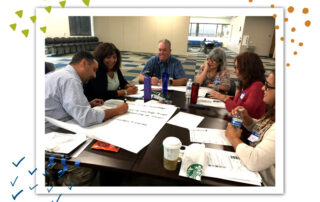
Are your team meetings making the best use of your time? Far from being something to just ‘get out of the way’, meetings should be seen as a vital part of running a successful organization, creating connection, collaboration, motivation, feedback and direction. Unfortunately, many of us have experienced meetings that lack any clear purpose and are easily derailed or meetings that have a purpose but for whatever reason simply don’t manage to achieve it.
I think we can safely say positive and productive meetings don’t just happen, they require planning, preparation and intention. However, how to have successful meetings is not commonly taught, there seems to be an assumption that people should just know how to have meetings.
As organizations are learning how to address remote working conditions and the office environment changes it is the perfect time to look at how things were being done in the past and possibly consider a new approach.
Positive and Productive Meetings is a training that can be offered virtually and in person. It focuses on very human elements that can deliver measurable results such as people coming to meetings prepared, meetings start and end on time, everyone leaves meetings with clear tasks and timelines and meetings have clear a purpose with defined outcomes.
Here are 5 top tips to start you on a path towards positive and productive meetings.
Meetings can often feel like a one-way street, with someone ‘in charge’ bringing together a group of people and dragging them along through an agenda whether they like it or not. To combat this we suggest creating a culture of shared responsibility, where more than one person has a specific meeting role and everyone understands that the meeting’s success both depends on them and is in their best interests.
People need to make time to attend a meeting, so it’s important to make them feel that this time was valued and appreciated. Although attendance at meetings may be mandatory, to get the most out of people’s contributions we want them to feel like their efforts to come along and participate are recognized.
There are different ways of making sure people feel valued and comfortable, and the environment and hospitality is one place to start. Using one-page profiles staff can share whether they like a particular type of coffee, or have a sweet tooth. You might also learn whether they work better visually or verbally, so you can think through whether it would be helpful to have flipcharts to draw on, or colored post-its to help to categorize ideas. When working virtually you can add music at the beginning and end and choose your collaboration tools (chat, annotate or Mural) appropriately.
People have different styles of communication, and it’s important to be aware of this so that you know everyone’s voice is being heard. Otherwise, some people may be being quiet not because they have nothing to say, but simply because they haven’t had the opportunity to say it. This could mean that important opinions go unsaid. You might recognize that someone has something to say but isn’t saying it through their body language, or you might want to think of a meeting structure that specifically gives each and every attendee a set opportunity to contribute in a way that suits them.
Outcome-focused agendas mean that people don’t just go into a meeting knowing what subjects will be talked about, but instead knowing what changes should be achieved as a result.
This outcomes-focused approach can help ensure that people feel that the meeting is worthwhile, and is focused on achieving something valuable and concrete. Going into meetings with this in mind mean that people are going to feel more interested in contributing, as they are working towards set goals.
Here it is important to understand both how outcomes are defined and how to ensure that you’re working towards them as a group. This is very different to turning up to the meeting with pre-defined solutions that you simply want to get approval for. Instead, outcome-driven approaches give the group a focus for creative thinking and idea generation that should result in valuable, vibrant discussions.
This final point isn’t about what you do in the meeting itself, but it is perhaps the single most important point in creating a long-term culture of purposeful meetings. After all, if teams realize that items are agreed as part of a meeting and then they aren’t followed up, they will simply lose interest in contributing ideas or making agreements in future meetings. This quickly becomes a negative cycle as people start to realize that the meetings are not resulting in any actual changes.
There are different ways of following up on actions, from sharing agreed task lists with the whole group, to personal follow ups on a one-on-one basis. Only by doing this can all the attendees have real confidence that their time at the meeting is being put to the best use, and that things will change in the future as a result of this time they are spending together.
The Positive and Productive Meetings method, developed by Helen Sanderson Associates, is a person-centered way of structuring meetings to get the most from them. To learn more about bringing a Positive and Productive Meetings training to your team contact Julie@helensandersonassociates.com
There was a problem reporting this post.
Please confirm you want to block this member.
You will no longer be able to:
Please note: This action will also remove this member from your connections and send a report to the site admin. Please allow a few minutes for this process to complete.